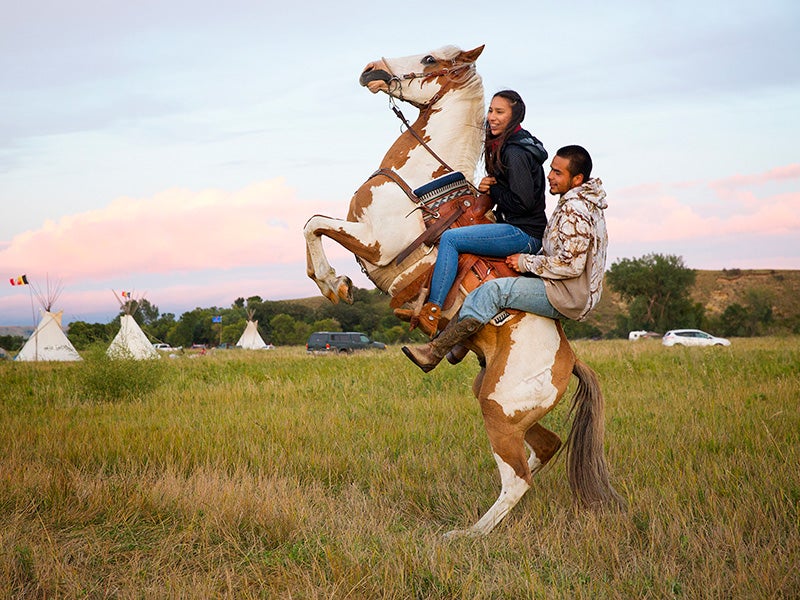Judge Orders Dakota Access Pipeline to Shut Down
Victory
—Unprecedented victory for Standing Rock Sioux Tribe after four-year legal battle
Contact
Owners of the Dakota Access Pipeline (DAPL) must halt operations while the government conducts a full-fledged analysis examining the risk DAPL poses to the Standing Rock Sioux Tribe, a federal judge ruled today. The court decision delivered a hard-fought victory to the Tribe, which has been engaged in a high-profile struggle against the Dakota Access Pipeline since 2016.
The ruling ordering a shutdown of DAPL marks the final word of a March 25 decision by the same judge. That ruling found that the U.S. Army Corps of Engineers had violated the National Environmental Policy Act (NEPA) and glossed over the devastating consequences of a potential oil spill when it affirmed its 2016 decision to permit the pipeline. The court ordered the Corps to re-examine the risks of the pipeline and prepare a full environmental impact statement, but left open the question as to whether pipeline operations would be halted as a legal remedy pending further briefing. After carefully analyzing the seriousness of the government’s legal violations, and the potential impacts on the Tribe and third parties, today’s decision concluded that shutting down the pipeline was necessary.
The shutdown will remain in place pending completion of a full environmental review, which normally takes several years, and the issuance of new permits. It may be up to a new administration to make final permitting decisions.
“Today is a historic day for the Standing Rock Sioux Tribe and the many people who have supported us in the fight against the pipeline,” said Chairman Mike Faith of the Standing Rock Sioux Tribe. “This pipeline should have never been built here. We told them that from the beginning.”
“It took four long years, but today justice has been served at Standing Rock,” said Earthjustice attorney Jan Hasselman, who represents the Tribe. “If the events of 2020 have taught us anything, it’s that health and justice must be prioritized early on in any decision-making process if we want to avoid a crisis later on.”
Write to your members of Congress in support of the Standing Rock Sioux Tribe and its fight for justice and sovereignty.
-
Alyssa Schukar / New York Times via Redux
Water protectors march to stop a working site near the Dakota Access Pipeline, Sept. 2016. -
Joe Brusky / Overpass Light Brigade / CC BY-NC 2.0
The Overpass Light Brigade at the Sacred Stone Camp, Nov. 28, 2016. -
Lucas Zhao / CC BY-NC 2.0
Flags fly at the Sacred Stone Camp, Nov. 16, 2016.
Background
In December of 2016, the Obama administration denied permits for DAPL to cross the Missouri River, and ordered a full environmental impact statement to analyze alternative pipeline routes and impacts on the Tribe’s treaty rights. Yet on his second day in office, Trump reversed that order, directing that permits be issued. Pipeline construction was completed by June of 2017.
The Standing Rock Sioux Tribe challenged the permits in court and won. The court ruled then that the environmental analysis had been insufficient because it failed to account for consequences facing the Tribe, and ordered the U.S. Army Corps of Engineers to redo it. However, the judge declined to shut down the pipeline in the interim.
The Army Corps then redid its environmental analysis, but shut the Tribe out of the review process, and concluded that its previous analysis had been sufficient and that nothing needed to change. In response, the Tribe, represented by Earthjustice, went back to court. In a motion for summary judgment filed last August, the Tribe asked the Court to shut down the pipeline, and order the Corps to conduct a full environmental analysis. The Court granted the Tribe’s request in a March 25, 2020 ruling, yet left open the question as to shutting down the pipeline in the interim.
The massive 2016 gathering of Tribes and allies defending Standing Rock Sioux territory from DAPL captured the world’s attention and attracted international media coverage. It helped give rise to a global movement of indigenous resistance to fossil-fuel infrastructure projects.
Resources
Standing Rock Sioux Tribe v. Army Corps of Engineers (PDF)
Standing Rock Sioux Tribe v. Army Corps of Engineers (Text)

Additional Resources
About Earthjustice
Earthjustice is the premier nonprofit environmental law organization. We wield the power of law and the strength of partnership to protect people's health, to preserve magnificent places and wildlife, to advance clean energy, and to combat climate change. We are here because the earth needs a good lawyer.